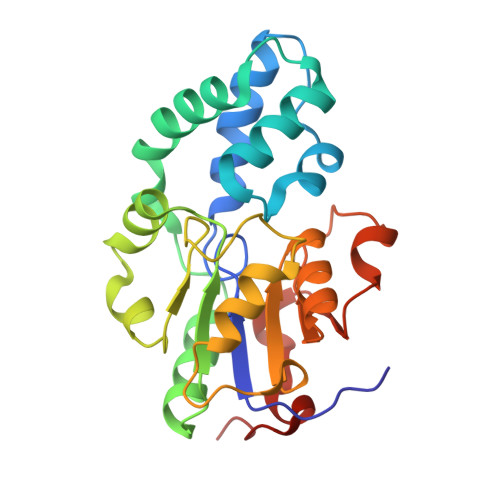Structural and functional insights into the substrate specificity of the pseudouridine monophosphate phosphatase HDHD1A.
Seo, S., Kim, M., Rhee, S.(2025) J Biological Chem 301: 110257-110257
- PubMed: 40409548
- DOI: https://doi.org/10.1016/j.jbc.2025.110257
- Primary Citation of Related Structures:
9M7L, 9M7M - PubMed Abstract:
Pseudouridine (Ψ) is one of the most abundant RNA modifications. Following RNA degradation, Ψ nucleotides are dephosphorylated and catabolized into uracil and ribose 5'-phosphate via a two-step enzymatic reaction catalyzed by enzymes present in many bacteria and eukaryotes, but not in mammals. Malfunction of Ψ catabolism has adverse physiological effects in plants. In humans, the enzyme HDHD1A dephosphorylates pseudouridine 5'-monophosphate (ΨMP), and the resulting Ψ is excreted in the urine. In this study, we determined the crystal structures of human HDHD1A (hHDHD1A) complexed with Ψ. The structure of hHDHD1A consists of a catalytic domain with a Rossmann α/β-fold and a cap domain, with a magnesium ion at the junction of the two domains. Ψ is bound to the active site in an orientation where its nucleobase, uracil-Ψ, is surrounded by the cap domain residues, and the ribose moiety is located next to the Mg 2+ -binding site. The active site is composed mainly of hydrophobic residues but two essential charged residues, Glu23 and Lys46, are present in the vicinity of uracil-Ψ. Glu23 interacts with the Ψ-specific N1 atom, while Lys46 interacts with the O2 atom of uracil-Ψ. Mutagenesis and kinetic analysis indicated that active site residues are involved in substrate binding and/or catalysis. In addition to Ψ-specific hydrophilic interactions, shape complementarity between ΨMP and the active site pocket is a key element underlying substrate specificity in hHDHD1A. This study provided structural and functional insights into the substrate specificity of hHDHD1A for ΨMP, highlighting both similarities and differences compared to other Ψ-recognizing enzymes.
- Department of Agricultural Biotechnology, Seoul National University, Seoul, Korea.
Organizational Affiliation:


















